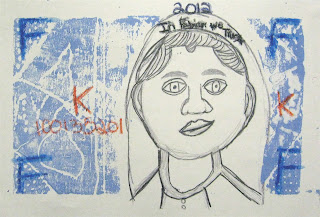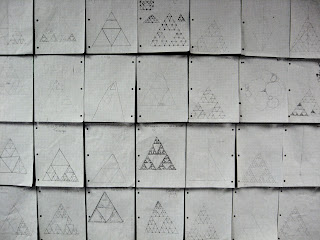In this extensive project, LPCA's middle school classes studied paper money, also known as bank notes, in depth. It began with the classes doing research on actual paper money from around the world so as to better understand the complexities of the design and detail of a bank note. Then they created their own paper money prototype. The focus had to be a self-portrait, and many criteria were required as far as details. The background was made by relief printmaking. Here is what the kids came up with:
Friday, November 23, 2012
Architectural Drawings for Kinders
While studying shapes and symmetry, the Kindergarten classes were challenged to put their understanding of simple geometry into practice by drawing step-by-step buildings. Here are the results:
INFINITE SERIES
Scholars studied the relationship between fine art and mathematics. They learned how fractals such as the Sierpinksi Triangle and the Apollonian Gasket, as well as triangulation, measurement, and equilateral triangles could be used to create very interesting geometric designs.
They started things off by watching a video about infinite series by Vi Hart called "Doodling in Math Class: Infinity Elephants."
Next, they got out their sketchbooks and practiced a few of the exercises shown in the video involving binary Apollonian gaskets, Sierpinski's triangle, and a technique involving three dots being used to draw a perfect circle.
Then they learned about horizon lines, vanishing points, scale, perspective, and repetition in an exercise that involved utilizing an infinite series.
Here is the math behind the scenes:
In this extensive study on geometric art involving fractals, triangulation, and infinite series, the classes were next required to create either a Sierpinski triangle or an Apollonian gasket on grid paper.
In preparation for their final piece, the classes were given inspiration by artwork that anchors itself around properties involving infinite series. In particular, students were shown the paintings of Alex Grey.
And finally, the students created their own finished pieces.
Perspective for Kinders
This was a step-by-step lesson for Kindergarten. They did their best to follow along in a challenging drawing lesson on one-point perspective (and their best was pretty impressive).
GOLDEN GATE BRIDGE
This lesson in architectural drawing techniques came after previous lessons on triangles, repetition, perspective, and horizon line. This prior knowledge was key in the children's individual development of their rendition of the Golden Gate Bridge.
The first step in the creation of this drawing was a direct teaching method of drawing the basic image step-by-step for the whole class to see. As the watched, they jotted down the most the could as they tried to keep up with Mr. Mueller's pace. The faster they become at sketching, the more comfortable they become at drawing in general.
Their preliminary sketches were fairly accurate and creatively inventive in some cases.
Then, each child was given a copy of the black and white photograph of the Golden Gate Bridge to fill in the detail, value, shading, and other finishing touches.
A few workshop-type lessons were given on how to shade in a sky with gradient value and how to erase puffs of clouds. This helped immensely with the overall quality of these drawings.
In the end, the finished products looked great!
The first step in the creation of this drawing was a direct teaching method of drawing the basic image step-by-step for the whole class to see. As the watched, they jotted down the most the could as they tried to keep up with Mr. Mueller's pace. The faster they become at sketching, the more comfortable they become at drawing in general.
Their preliminary sketches were fairly accurate and creatively inventive in some cases.
Then, each child was given a copy of the black and white photograph of the Golden Gate Bridge to fill in the detail, value, shading, and other finishing touches.
A few workshop-type lessons were given on how to shade in a sky with gradient value and how to erase puffs of clouds. This helped immensely with the overall quality of these drawings.
In the end, the finished products looked great!
Subscribe to:
Posts (Atom)












































.jpg)





